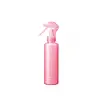What's inside
What's inside
 Key Ingredients
Key Ingredients

 Benefits
Benefits

 Concerns
Concerns

 Ingredients Side-by-side
Ingredients Side-by-side

Water
Skin ConditioningAlcohol
AntimicrobialAmodimethicone
Glycerin
HumectantPhenoxyethanol
PreservativeCetrimonium Chloride
AntimicrobialDimethicone
EmollientSodium Citrate
BufferingDicocodimonium Chloride
EmulsifyingCitric Acid
BufferingSteartrimonium Chloride
PreservativePEG-200 Hydrogenated Castor Oil
EmulsifyingHydrolyzed Hyaluronic Acid
HumectantCreatine
Skin ConditioningCetearamidoethyl Diethonium Hydrolyzed Rice Protein
Sodium Dilauramidoglutamide Lysine
HumectantPropanediol
SolventDistearyldimonium Chloride
Behentrimonium Chloride
PreservativeGamma-Docosalactone
Skin ConditioningPhytosterols
Skin ConditioningCeteth-20
CleansingIsopropyl Alcohol
SolventWater, Alcohol, Amodimethicone, Glycerin, Phenoxyethanol, Cetrimonium Chloride, Dimethicone, Sodium Citrate, Dicocodimonium Chloride, Citric Acid, Steartrimonium Chloride, PEG-200 Hydrogenated Castor Oil, Hydrolyzed Hyaluronic Acid, Creatine, Cetearamidoethyl Diethonium Hydrolyzed Rice Protein, Sodium Dilauramidoglutamide Lysine, Propanediol, Distearyldimonium Chloride, Behentrimonium Chloride, Gamma-Docosalactone, Phytosterols, Ceteth-20, Isopropyl Alcohol
Water
Skin ConditioningDimethicone
EmollientNeopentyl Glycol Diethylhexanoate
EmollientPEG-8
HumectantSorbitol
HumectantSodium Dilauramidoglutamide Lysine
HumectantHydrolyzed Pea Protein
EmollientHydrolyzed Collagen
EmollientHydrolyzed Silk
HumectantPPG-10 Methyl Glucose Ether
Skin ConditioningDiethyl Sebacate
EmollientCamellia Sinensis Seed Oil
HumectantBis-Ethoxydiglycol Cyclohexane 1,4-Dicarboxylate
EmollientCeramide NP
Skin ConditioningCeramide AP
Skin ConditioningCamellia Japonica Seed Oil
EmollientAmodimethicone
Dimethiconol
EmollientCholesterol
EmollientDicocodimonium Chloride
EmulsifyingSteartrimonium Chloride
PreservativeHydroxyethylcellulose
Emulsion StabilisingGlyceryl Stearate
EmollientPEG-200 Hydrogenated Castor Oil
EmulsifyingBehentrimonium Methosulfate
Cetrimonium Chloride
AntimicrobialQuaternium-18
Quaternium-33
Cetearyl Alcohol
EmollientStearyl Alcohol
EmollientPropylene Glycol
HumectantDisodium EDTA
Phenoxyethanol
PreservativeWater, Dimethicone, Neopentyl Glycol Diethylhexanoate, PEG-8, Sorbitol, Sodium Dilauramidoglutamide Lysine, Hydrolyzed Pea Protein, Hydrolyzed Collagen, Hydrolyzed Silk, PPG-10 Methyl Glucose Ether, Diethyl Sebacate, Camellia Sinensis Seed Oil, Bis-Ethoxydiglycol Cyclohexane 1,4-Dicarboxylate, Ceramide NP, Ceramide AP, Camellia Japonica Seed Oil, Amodimethicone, Dimethiconol, Cholesterol, Dicocodimonium Chloride, Steartrimonium Chloride, Hydroxyethylcellulose, Glyceryl Stearate, PEG-200 Hydrogenated Castor Oil, Behentrimonium Methosulfate, Cetrimonium Chloride, Quaternium-18, Quaternium-33, Cetearyl Alcohol, Stearyl Alcohol, Propylene Glycol, Disodium EDTA, Phenoxyethanol
Ingredients Explained
These ingredients are found in both products.
Ingredients higher up in an ingredient list are typically present in a larger amount.
This water-soluble silicone is used for its hydrating and softening properties. It is used to add a silky feel to skincare products and has great benefits for haircare.
In haircare, this ingredient:
- Adds shine
- Protects color
- Offers thermal protection
- Boosts hair strength
- Does not build up as easily
This ingredient is a preservative, antimicrobial, and emulsifier. It is often used in cosmetics for its ability to cleanse, condition, and reduce static.
Cetrimonium chloride is a quaternary ammonium salt, meaning it has a water-soluble structure.
We don't have a description for Dicocodimonium Chloride yet.
Dimethicone is a type of synthetic silicone created from natural materials such as quartz.
What it does:
Dimethicone comes in different viscosities:
Depending on the viscosity, dimethicone has different properties.
Ingredients lists don't always show which type is used, so we recommend reaching out to the brand if you have questions about the viscosity.
This ingredient is unlikely to cause irritation because it does not get absorbed into skin. However, people with silicone allergies should be careful about using this ingredient.
Note: Dimethicone may contribute to pilling. This is because it is not oil or water soluble, so pilling may occur when layered with products. When mixed with heavy oils in a formula, the outcome is also quite greasy.
Learn more about DimethiconePEG-200 Hydrogenated Castor Oil is an oil and isn't fungal acne safe.
Phenoxyethanol is a preservative that has germicide, antimicrobial, and aromatic properties. Studies show that phenoxyethanol can prevent microbial growth. By itself, it has a scent that is similar to that of a rose.
It's often used in formulations along with Caprylyl Glycol to preserve the shelf life of products.
We don't have a description for Sodium Dilauramidoglutamide Lysine yet.
Steartrimonium Chloride is a preservative.
Water. It's the most common cosmetic ingredient of all. You'll usually see it at the top of ingredient lists, meaning that it makes up the largest part of the product.
So why is it so popular? Water most often acts as a solvent - this means that it helps dissolve other ingredients into the formulation.
You'll also recognize water as that liquid we all need to stay alive. If you see this, drink a glass of water. Stay hydrated!
Learn more about Water